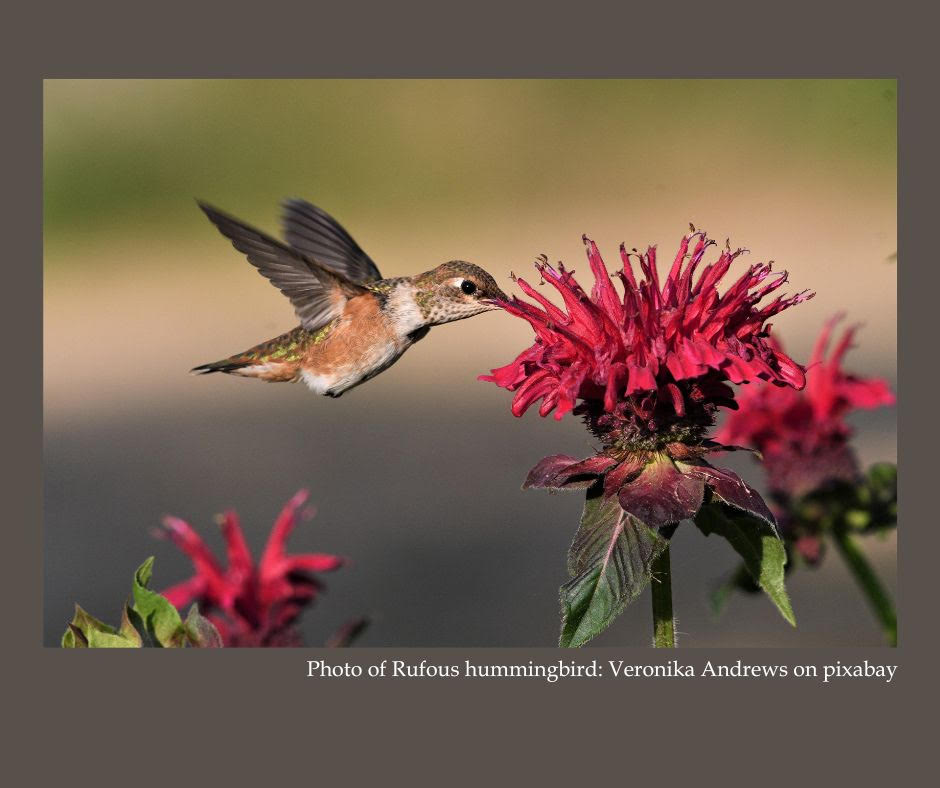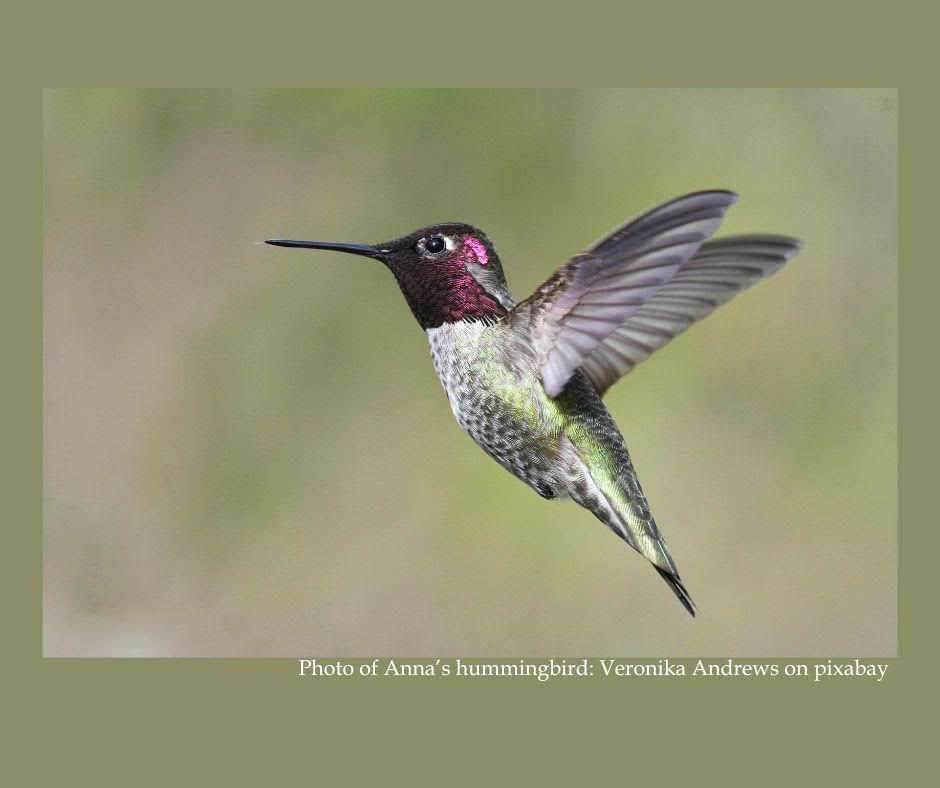Hummingbirds are Here!

By: Susie Hairston
It’s official: hummingbirds are here! The fall migration has started, so keep your eyes peeled for that quick flash of green sparkling in the sunlight as one darts past or for that buzzing/humming sound that’s slightly louder than a bee, as their tiny wings beat somewhere in your close vicinity.
Hummers, as they are nicknamed, migrate through Houston in the fall and spring. The fall migration occurs from August through October, peaking in September, as the hummers head back to Mexico and Central America. Some species, such as the Rufous and the Black-chinned hummingbird will overwinter in Houston. Collectively, these beautiful, iridescent birds are referred to as flying jewels, a bouquet, a shimmer, a charm, or a glittering. They are some of the smallest birds in the world. But don’t let their beauty and tininess tempt you to underestimate them.These tough little guys fly thousands of miles as they migrate, and despite the long list of collective nicknames, they migrate alone, sometimes covering 500 miles in a day solo. They are extremely territorial about their food sources, fighting with other hummingbirds over a patch of native flowers or a hummingbird feeder.
Their fierce defense of their food supply makes sense when you realize that they have an extremely fast metabolism (the highest of any warm blooded animal), their wings beat between 720 and 5400 times/minute when they are hovering, and they have to feed every 10-15 minutes, visiting thousands of flowers and eating from 1.5 – 3 times their body weight every day.
The Americas from Tierra del Fuego on the tip of South America to Alaska are the only continents where these amazing creatures are found. There are 330+ species of hummingbird, most of which reside south of the U.S.
Hummingbirds we most commonly see in the Houston area are Ruby-throated, Rufous, and Black-chinned. Though Allen’s, Anna’s, Broad-tailed, and Buff-bellied hummingbirds also visit us here.
There are lots of fun facts about hummingbirds, but two of my favorites are:
- They are the only birds that can fly backwards.
- They have amazing memories and a sense of time, remembering every flower they’ve visited and how long it takes for a certain flower to refill.

Role hummingbirds play in our shared ecosystem:
As pollinators, they help many native flowering plants reproduce, and that helps maintain biodiversity. In addition to drinking nectar, they also eat a lot of small insects, providing pest control for insects that damage plants. They are considered a sentinel species because they are highly sensitive to environmental changes such as climate shifts and habitat disruption. A decline in hummingbird numbers or a change in their behavior can alert us to environmental problems before they become noticeable on a larger scale.
PSA: biggest threat to hummingbirds:
Several things threaten hummingbirds, but one of the most common, and the one that we as individuals can most easily do something about is illness and death caused by hummingbird feeders. It’s estimated that several thousand hummingbirds die every year from health problems caused by dirty feeders, spoiled sugar water and toxic commercial nectar.
How to safely attract and feed hummingbirds in your backyard:
Hummingbirds prefer nectar from native plants to sugar water, so the very best thing you can do for them is to plant a variety of native plants that specifically appeal to hummingbirds.Make sure you choose diverse plants which bloom at different times of year, providing nectar sources during all seasons the hummers visit. I can personally vouch for the fact that they like red Turk’s Cap at this time of year. Houston Audubon has a list of suitable natives here: Buchanan’s Native Plants has a list here: You can pick up some native plants to plant in preparation for the spring migration at Houston Arboretum and Nature Center’s fall plant sale on Saturday October 3rd or at Houston Audubon’s Edith L Moore Nature Sanctuary Native Nursery plant sale on Saturday October 11th. You can also check with the Native Plant Society, Houston chapter to get more details about their next native plant sale on September 27th.
If you want to put up hummingbird feeders, do it in a way that is safe for hummingbirds:
- Use only granulated white cane sugar when preparing the food. Use 1 part sugar to 4 parts water
- If you heat the mixture to better dissolve the sugar, make sure it is completely cooled down before putting it in the feeder
- Thoroughly clean your feeder daily, particularly here in Houston where heat, humidity and ever present mold spores can cause the sugar water to start growing mold/bacteria that can kill the hummers
- Whether you use hot water and soap or vinegar, make sure you completely rinse out any residue that could make the hummingbirds sick
- Do not use commercially made hummingbird food, brown sugar, honey, or artificial sweeteners in the feeder
- Do not use red dye
Want to see a lot of migrating hummingbirds up close and personal? Gulf Coast Bird Observatory is holding its annual Xtreme Hummingbird Xtravaganza on September 13th and 20th from 8 am to 12pm in Lake Jackson.
Happy hummingbird spotting!
Resources and References:
More interesting facts about hummingbirds:
https://hummingbirds.vetmed.
Information on specific species of hummingbirds, threats to hummingbirds, and a thorough list of things we can each do to help protect them.https://www.fws.gov/
More detailed information about the migration patterns of various hummingbird species:
https://www.audubon.org/
First of or a variety of info on hummingbirds in Houston, including an extensive list of native plants that will attract them:
https://houstonaudubon.org/
Photos and info on all hummingbirds seen in the U.S.:
https://abcbirds.org/blog21/
Other hummingbird resources:
https://augusta.wbu.com/
https://journeynorth.org/tm/
https://journeynorth.org/tm/
https://journeynorth.org/
https://www.audubon.org/